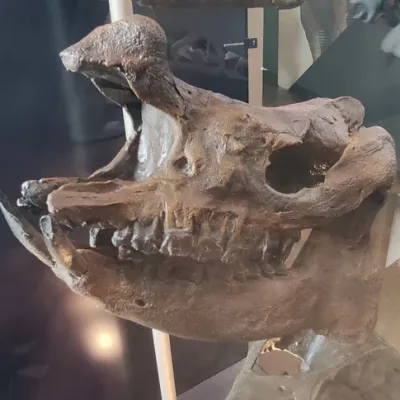A Journey Through Panama’s Past and Future: Exploring the Biomuseum at Amador Causeway

It was a sunny Sunday…
and we decided to head out to the Amador Causeway, one of our favorite spots in Panama City, to visit the Biomuseum. It’s an extraordinary place to visit any day of the week.
The Biomuseum itself is quite the sight. Designed by renowned architect Frank Gehry, this is his first project in Latin America. The structure is a unique representation of Panama’s natural landscape, with a roof meant to resemble a forest canopy. The view from above is stunning, but we’ll save that for another time—today, we explored it on foot.

About Amador Causeway
We parked the car and began our walk, soaking in the history we had forgotten. Some of the buildings nearby were once part of a U.S. military base, and it’s fascinating to remember how this area used to look. The Amador Causeway was built using rocks and debris from the Panama Canal excavation, connecting what were originally three small islands.

It’s all in the details
Entry tickets to the Biomuseum cost $10 for Panamanian residents and $20 for tourists. They offer free audio guides through their website, which are a great addition to the visit because the magic of the museum is all in the small details.
As you enter, the first room feels like a lobby, introducing visitors to Panama’s wildlife. Here, you’ll learn about iconic species like the Harpy Eagle and the Golden Frog, both endangered. I suggest wandering at your own pace, following the audio guide to fully appreciate each exhibit.

The Panamarama
Next, we entered the Panamarama—a 360-degree immersive theater with screens all around, even beneath your feet! It’s an exhilarating experience, and I highly recommend sitting down so you can fully enjoy it. I found myself feeling like a kid, full of wonder, as we watched the stunning visuals.
Things to do in Panama City
Tours you can do in Panama City to enjoy your stay even more.
A jump to the past
With our energy levels up, we ventured into the fossils room. This is the place to take your time, as you’ll want to touch and observe everything. The exhibits explain how volcanic activity created the land bridge that allowed species to migrate between North and South America. There are life-sized sculptures of massive prehistoric animals, from saber-toothed cats to giant sloths. Imagining a world full of these creatures is both exciting and a bit terrifying!
We then moved on to the section on human history, where the story of the indigenous peoples of Panama is told. The exhibits show how this tiny isthmus connected cultures across the Americas. Although there’s a lot of reading in this section, it’s a good spot to take a break, sit down, and catch your breath.

Take a deep dive
After a rest, we reached the aquariums—my personal favorite. You’ll see marine environments like coral reefs and mangroves, but the stars of the show are the massive aquariums filled with water from both the Atlantic and Pacific Oceans. It’s incredible to observe the differences in salinity and marine life from each side of the isthmus.

It’s all connected
Finally, we explored an interactive exhibit explaining the complex relationships between different species in Panama’s ecosystems. This part of the museum features old-fashioned telephone-style receivers and various screens, showing how termites and parakeets or how wasps and figs (photo), among others, depend on one another. It’s surprisingly fun and you’ll find yourself looking in all directions to follow the story!

A snack!
Our last stop was a giant megalodon jaw. Standing next to it, I couldn’t help but imagine being a snack for the largest shark that ever existed.
The fun didn’t end when we stepped outside. The museum’s gardens are home to hummingbirds, butterflies, and depending on the time of day, you might spot iguanas or raccoons. We were lucky enough to catch a contemporary dance festival that was taking place that weekend. The museum frequently hosts events for all ages, so it’s worth checking their calendar.

Some tips before visiting
After two hours of exploring, we felt like we had rediscovered Panama. The museum closes at 3 p.m. on weekdays and Saturdays, and 4 p.m. on Sundays, so it’s a good idea to arrive early. Plus, you’ll want extra time to enjoy the Amador Causeway’s amazing views of the Panama City skyline and the entrance to the Canal.
If you visit, be sure to grab some snacks, drinks, or even a shaved ice (raspao) treat from one of the vendors. You can also rent bikes to tour the Causeway, but don’t forget your sunscreen and hat—just watch out for the wind, or you might lose it!





